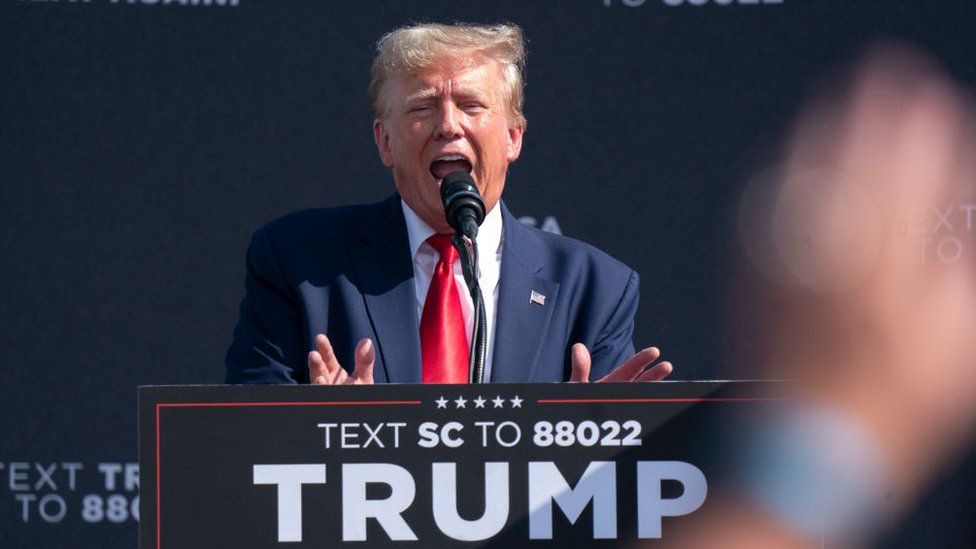Fact-checking Donald Trump's claim that wind turbines kill whales
- Published

Former US President Donald Trump has claimed that wind turbines off the coast of the US "are causing whales to die in numbers never seen before".
These claims have attracted significant attention on social media, where a clip of Mr Trump's speech has now been viewed more than nine million times.
But Mr Trump's claims are not backed up by evidence.
What is being claimed?
Speaking at a rally in South Carolina on Monday, Mr Trump suggested that "windmills" used to generate electricity are driving whales "crazy", and dead whales are washing ashore "on a weekly basis".
Some conservationists have raised concerns about whale deaths near the development of an offshore wind farm off the US east coast.
This series of strandings led some Republican lawmakers to call for a temporary halt to all development of offshore wind farms, and further research into possible links to humpback whale deaths.
Since then, hundreds of posts, external wrongly linking wind farms to whale deaths have been spreading on social media, with hundreds of thousands of views.
How many whales are dying?
The US National Oceanic and Atmospheric Administration (NOAA) says that, since 2016, a total of 208 humpback whales, external have been stranded along the country's east coast.
The problem was deemed so serious that, in 2017, the US agency dubbed it an "unusual mortality event, external".
A dead beached whale lies off the coast of New York on 13 December 2022.
NOAA data shows 2023 has been one of the worst years in the last decade when it comes to humpback whale deaths in the US, with 33 strandings so far.
In a speech on Monday, external, Mr Trump claimed that "only one such whale" was killed off the coast of South Carolina "in the last 50 years".
But records, external from the South Carolina Department of Natural Resources show that, since 1993, at least seven humpback whale strandings have been reported in the state.
Is there evidence linking whale deaths to wind turbines?
There is no evidence to back Mr Trump's suggestion that offshore wind turbines are killing whales.
NOAA officials carried out post-mortem examinations on about 90 humpback whales found dead since 2016.
Forty per cent of those deaths were linked, external to human interaction - whales becoming entangled in fishing nets, or being struck by vessels travelling through their feeding grounds.
In the remaining cases investigated by NOAA, other factors were listed as possible causes of death, including parasite-caused organ damage or starvation.
In some cases, the advanced stage of decomposition of the carcasses meant it was impossible to conclusively determine the cause of death.
"We know what the main threats are to humpback whales: it's very much the impact from things like fishing and ship strikes," says Rob Deaville from the Zoological Society of London's Cetacean Strandings Investigation Programme.
"To talk about wind farms being a problem takes away discussion around the very real threats that are a problem for those species."
Many other areas with high numbers of wind farms have not seen an increase in whale mortality.
For example, the UK is home to the world's four largest wind farms, but no humpback whale strandings there have been conclusively linked to the impact of those farms.
Can offshore wind farms affect marine wildlife?
NOAA says there are "no known links" between recent large whale mortality rates and offshore wind surveys. But that doesn't mean building windfarms comes at no cost for natural habitats.
Before offshore wind farms are built, the ocean floor needs to be surveyed by sending acoustic waves into it.
Some activists have, in the past, suggested that using such techniques might lead to whale deaths.
"There's lots of evidence that when you're putting the wind farms in place, it does generate a lot of percussive noise, and that can have an impact," says Mr Deaville.
"Particularly things like porpoises or dolphins, they may move out of that area while you're installing the wind farms, but then the longer-term picture: in some areas they never come back, in some they come back in larger numbers than before."
- Published23 January 2023